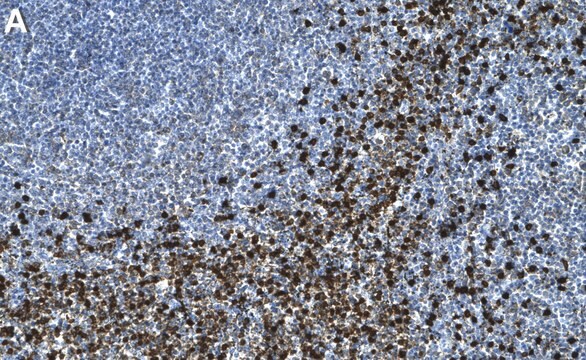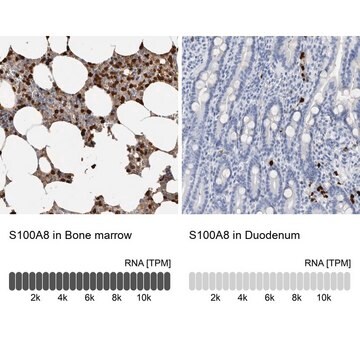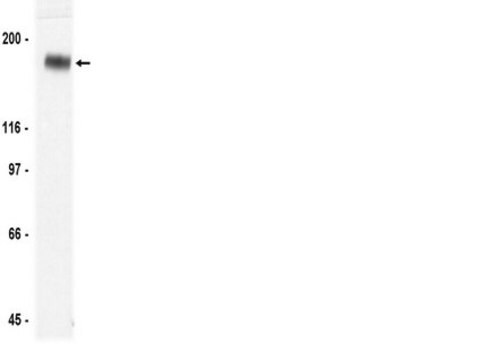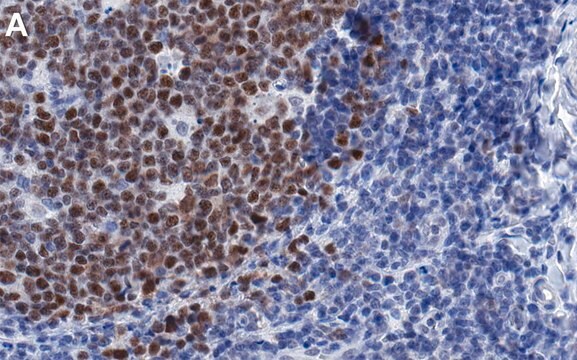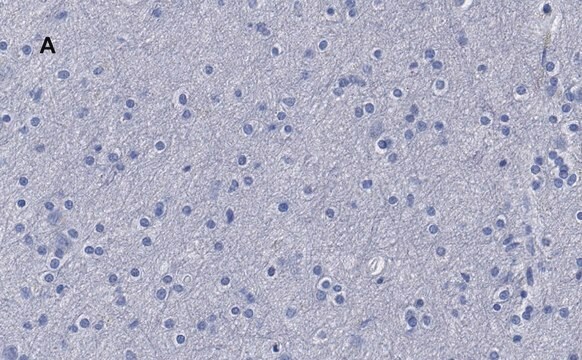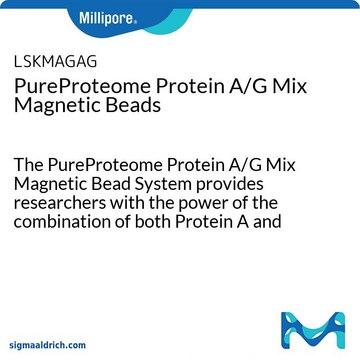MABF291
Anti-S100A8/S100A9 Antibody, clone 5.5
clone 5.5, from mouse
别名:
Protein S100-A9, Calgranulin-B, Calprotectin L1H subunit, Leukocyte L1 complex heavy chain, Migration inhibitory factor-related protein 14, S100 calcium-binding protein A9, AMRP-14, p14, Protein S100-A8, Calgranulin-A, Calprotectin L1L subunit, Cystic fi
登录查看公司和协议定价
所有图片(1)
About This Item
分類程式碼代碼:
12352203
eCl@ss:
32160702
NACRES:
NA.41
推荐产品
生物源
mouse
品質等級
抗體表格
purified immunoglobulin
抗體產品種類
primary antibodies
無性繁殖
5.5, monoclonal
物種活性
human
技術
ELISA: suitable
flow cytometry: suitable
immunohistochemistry: suitable
immunoprecipitation (IP): suitable
western blot: suitable
同型
IgG1κ
運輸包裝
wet ice
目標翻譯後修改
unmodified
基因資訊
human ... S100A8(6279) , S100A9(6280)
一般說明
S100A8, also known as Protein S100-A8, Calgranulin-A, Calprotectin L1L subunit, Cystic fibrosis antigen (CFAG), Leukocyte L1 complex light chain, Migration inhibitory factor related protein 8 (MRP-8), p8, S100 calcium binding protein A8, or Urinary stone protein band A, and encoded by the gene S100A8/CAGA/CFAG/MRP8, is an important protein that binds both zinc and calcium and plays an important role in the regulation of inflammatory processes and immune response. Found in complex with its partner S100A9, S100A8 facilitates chemotaxis, fatty acid trafficking, cytoskeleton reorganization, and NAPDPH oxidase activation and other intracellular activities, as well as a host of extracellular induced activities such as extracellular proinflammatory, antimicrobial, oxidant scavenging, and apoptotic activities . Additionally S100A8 can act as a potent autoimmunity amplifier and appears to augment various cancers and their spread when over expressed. S100A8 is widely expressed and used as biomarker in patients with inflammatory diseases and as a cancer marker in multiple forms of cancer.
特異性
This antibody detects both S100A8 and S100A9.
免疫原
Whole cells expressing Human S100A8 & S100A9.
應用
Research Category
Inflammation & Immunology
Inflammation & Immunology
Research Sub Category
Immunological Signaling
Immunological Signaling
This Anti-S100A8/S100A9 Antibody, clone 5.5 is validated for use in Flow Cytometry and Immunoprecipitation and Immunohistochemistry and ELISA and Western Blotting for the detection of S100A8/S100A9.
Western Blotting Analysis: A representative lot of this antibody was used to detect S100A8/S100A9 in Human monocyte and neutrophil extracts (Edgeworth, J., et al., (1991) JBC. 266(12):7706-7713).
Western Blotting Analysis: A representative lot of this antibody was used to detect S100A8/S100A9 in neutrophil extracts (Hogg et al., 1989).
Immunoprecipitation Analysis: A representative lot of this antibody was used to detect S100A8/S100A9 in Human monocyte and neutrophil lysate (Edgeworth, J., et al., (1991) JBC. 266(12):7706-7713).
Immunoprecipitation Analysis: A representative lot of this antibody was used to detect S100A8/S100A9 in MRP-8 and TL-14 mutant lysate (Hessian P.A., et al., (2001) Eur. J. Biochem. 268:353-363).
Immunohistochemistry Analysis: A representative lot of this antibody was used to detect S100A8/S100A9 in Human Bronchus tissue (Hogg, N., et al., (1989) Eur. J. Immunol. 19:1053-1061).
Immunohistochemistry Analysis: A representative lot of this antibody was used to detect S100A8/S100A9 in spleen and thymus tissue (Hogg, N., et al., (1989) Eur. J. Immunol. 19:1053-1061).
ELISA: A representative lot of this antibody was used to detect S100A8/S100A9 in ELISA (Ryckman, C., et al., (2003) Arthritis & Rheumatism. 48(8):2310-2320).
Western Blotting Analysis: A representative lot of this antibody was used to detect S100A8/S100A9 in neutrophil extracts (Hogg et al., 1989).
Immunoprecipitation Analysis: A representative lot of this antibody was used to detect S100A8/S100A9 in Human monocyte and neutrophil lysate (Edgeworth, J., et al., (1991) JBC. 266(12):7706-7713).
Immunoprecipitation Analysis: A representative lot of this antibody was used to detect S100A8/S100A9 in MRP-8 and TL-14 mutant lysate (Hessian P.A., et al., (2001) Eur. J. Biochem. 268:353-363).
Immunohistochemistry Analysis: A representative lot of this antibody was used to detect S100A8/S100A9 in Human Bronchus tissue (Hogg, N., et al., (1989) Eur. J. Immunol. 19:1053-1061).
Immunohistochemistry Analysis: A representative lot of this antibody was used to detect S100A8/S100A9 in spleen and thymus tissue (Hogg, N., et al., (1989) Eur. J. Immunol. 19:1053-1061).
ELISA: A representative lot of this antibody was used to detect S100A8/S100A9 in ELISA (Ryckman, C., et al., (2003) Arthritis & Rheumatism. 48(8):2310-2320).
品質
Evaluated by Flow Cytometry on Human PBMCs.
Flow Cytometry Analysis: A 1:80 dilution (0.25 µg) of this antibody detected S100A8 and/or S100A9 in 1x10E6 PBMCs.
Flow Cytometry Analysis: A 1:80 dilution (0.25 µg) of this antibody detected S100A8 and/or S100A9 in 1x10E6 PBMCs.
標靶描述
~8 kda(11kDa) and 14 kDa and as a heterodimer it would be ~24 kDa (under native conditions)
外觀
Protein G Purified
Format: Purified
Purified mouse monoclonal IgG1κ in buffer containing 0.1 M Tris-Glycine (pH 7.4), 150 mM NaCl with 0.05% sodium azide.
儲存和穩定性
Stable for 1 year at 2-8°C from date of receipt.
其他說明
Concentration: Please refer to lot specific datasheet.
免責聲明
Unless otherwise stated in our catalog or other company documentation accompanying the product(s), our products are intended for research use only and are not to be used for any other purpose, which includes but is not limited to, unauthorized commercial uses, in vitro diagnostic uses, ex vivo or in vivo therapeutic uses or any type of consumption or application to humans or animals.
未找到合适的产品?
试试我们的产品选型工具.
儲存類別代碼
12 - Non Combustible Liquids
水污染物質分類(WGK)
WGK 1
閃點(°F)
Not applicable
閃點(°C)
Not applicable
Identification of p8,14 as a highly abundant heterodimeric calcium binding protein complex of myeloid cells.
Edgeworth, J, et al.
The Journal of Biological Chemistry, 266, 7706-7713 (1991)
Monoclonal antibody 5.5 reacts with p8,14, a myeloid molecule associated with some vascular endothelium.
Hogg, N, et al.
European Journal of Immunology, 19, 1053-1061 (1989)
P A Hessian et al.
European journal of biochemistry, 268(2), 353-363 (2001-02-13)
The S100 calcium-binding proteins MRP-8 (S100A8) and MRP-14 (S100A9) form a heterodimeric complex in the cytosol of monocyte and neutrophil cell types circulating in peripheral blood. This complex, but not the individual subunit proteins, is specifically recognized by mAb 27E10.
Carle Ryckman et al.
Arthritis and rheumatism, 48(8), 2310-2320 (2003-08-09)
To examine the role of chemokines, S100A8, and S100A9 in neutrophil accumulation induced by the causative agent of gout, monosodium urate monohydrate (MSU) crystals. MSU crystal-induced neutrophil migration was studied in the murine air-pouch model. Release of chemokines, S100A8, S100A9
我们的科学家团队拥有各种研究领域经验,包括生命科学、材料科学、化学合成、色谱、分析及许多其他领域.
联系技术服务部门